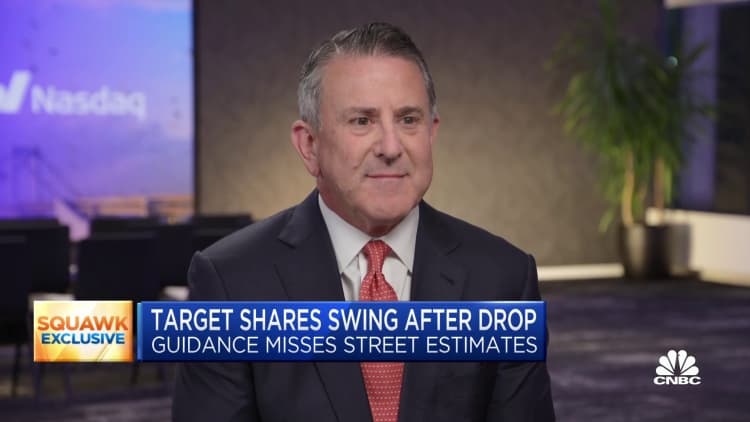Target ekes out slight growth in holiday-quarter sales, but warns of continued slowdown
A shopper leaves a Target store in New York, August 15, 2021.
Scott Mlyn | CNBC
Target on Tuesday topped Wall Street’s earnings expectations for the first time in a year, as its holiday-quarter sales rose roughly 1% from the same period a year prior.
Still, the big-box retailer revealed shrinking profit and margins and gave a conservative full-year outlook, saying customers are tossing fewer discretionary items into their shopping carts.
The company said it expects that comparable sales, a key metric that tracks sales at stores open at least 13 months and online, will range from a low single-digit decline to a low single-digit increase for fiscal 2023. Target said it expects full-year earnings per share of between $7.75 and $8.75. That was below Wall Street’s expectations of $9.23 per share, according to StreetAccount estimates.
CEO Brian Cornell said in a release the company performed well, despite “a very challenging environment,” with groceries, beauty items and household essentials lifting sales as consumers focused on necessities.
“I think we’re being appropriate with our guidance in this environment,” Cornell said Tuesday morning on CNBC’s “Squawk Box.” “We know inflation is still high — it’s been very stubborn. It’s still at a very high level. We know interest rates are rising. And we’re going to watch the consumer really carefully.”
Cornell will share more of Target’s plans for the year at an investor day in New York City later Tuesday morning.
Shares of Target were up slightly in premarket trading Tuesday.
Here’s what the company reported for its fiscal fourth quarter that ended Jan. 28, compared with Refinitiv consensus estimates:
- Earnings per share: $1.89 vs. $1.40 expected
- Revenue: $31.4 billion vs. $30.72 billion expected
Though the company beat on the top and bottom lines, it cleared a bar that had been substantially lowered in recent months.
The big-box retailer, known for its lower-priced, but fashion-forward clothing, home goods and more, saw sales spike during the first two years of the Covid pandemic. Its annual total revenue has grown by about $31 billion – or nearly 40% – from fiscal 2019 to 2022.
Yet over the past year, Target has faced a shift in both sales trends and market sentiment. The discounter became a poster child in the industry for inventory troubles, squeezed profit margins and concerns about inflation-pinched, middle-income consumers. The company missed Wall Street’s earnings expectations for the first three quarters of the fiscal year and warned investors to expect softer holiday sales.
Target’s net income for the period, which runs from November through January, fell by about 43% to $876 million, or $1.89 per share, from $1.54 billion, or $3.21 per share in the year-ago period.
Comparable sales, also called same-store sales, rose 0.7% in the quarter. That surpassed Wall Street’s expectations for a decline of 1.6%, according to StreetAccount estimates.
Customer traffic, which includes online and in stores, grew by 0.7% in the fourth quarter, though Target’s average ticket was roughly flat.
Target said needs-based merchandise sold better in the quarter. Food and beverage made up its strongest category, with comparable sales rising by low double digits year over year. Essentials and beauty increased by high single digits, and several discretionary-focused categories, including home and apparel, declined, but the company didn’t specify by how much.

The company’s private-label brands, which are often cheaper than national brands, grew at a faster pace than overall sales.
One of Target’s weakest points has been its profit margins, which have been weighed down by markdowns and higher supply chain costs. Last summer, Target announced an aggressive inventory plan to clear through unwanted goods.
Its inventory levels are in better shape than previous quarters, dropping by 3% year over year during the fiscal fourth quarter. Its inventory had been up about 14% year over year in the third quarter, 36% in the second quarter and 43% in the first quarter.
Target said that it has a different mix of merchandise, too. Inventory in discretionary categories fell about 13% compared with a year ago, as the retailer ordered more high-frequency items like food and paper towels.
“We realized consumer spending habits have changed,” Cornell said on “Squawk Box.” “So we took a pretty bold action and said, ‘We’re going to address inventory. We’re going to get our inventory levels right.’ We finished the year exactly where we wanted to be.”
The company has missed its goal of reaching healthier margins, though. It had promised an operating income margin rate around 6% in the back half of the fiscal year, when it cut its profit outlook in June for the second time. For the fourth quarter, Target’s operating margin was 3.7%, weaker than the 3.9% it posted for the third quarter but ahead of the 3.1% Wall Street was looking for, according to StreetAccount estimates.
“We’re on a multiyear journey to get back to pre-pandemic margin levels,” Cornell said. “Right now, mix is certainly impacting margins. We’re selling more lower-margin items like food and beverage and household essentials, and less of apparel and home, but that’s going to moderate over time.”
Target now says it plans to return to its pre-pandemic rate of 6% beginning next fiscal year or later, depending on the economic backdrop and consumer demand.
Target’s stock has fallen nearly 40% from its all-time closing high. It closed Monday at $166.81 per share, bringing its market value to nearly $77 billion. So far this year, however, its shares have been up about 12% and outpaced the almost 4% growth of the S&P 500.

For all the latest Technology News Click Here

